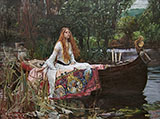The Lady of Shallot 1888 By John William Waterhouse
John William Waterhouse, The Lady of Shalott, painted in 1888, a masterpiece of pre-raphaelite painting.
Famed for its beauty and poignant tragedy, it's one of our 100 most famous paintings. But who was the Lady of Shalott, and what inspired the painting?
What is the story behind The Lady of Shalott?
This John William Waterhouse painting illustrates the events of Alfred Lord Tennyson's poem. Also titled The Lady of Shalott, it describes a woman imprisoned in a tower.
She's cursed to only view the outside world through reflections in a mirror. Never leaving the building, she weaves these reflections into a tapestry. One day, the lady glimpses the fabled knight, Sir Lancelot, through her mirror. Full of unrequited love, she turns to gaze at him directly.
From this fateful moment, the curse lies on her shoulders. As a result, the woman drifts down the nearby river in sorrow, sailing towards King Arthur's Castle at Camelot. Singing her last song as she floats along the waters, she dies before reaching her destination.
The knights and ladies of Camelot later found her frozen body. On discovering her sad fate, Lancelot prayed to God for mercy on her soul.
Tennyson's poem inspired many of Pre-Raphaelites paintings. It particularly influenced Waterhouse, who owned a copy of Tennyson's complete works. He covered every blank page with ideas for future paintings.
Other Pre-Raphaelite artists, such as Dante Gabriel Rossetti and William Holman Hunt, also painted the Lady of Shalott.
What is the story of John William Waterhouse's painting?
The Lady of Shalott painting is full of symbolism. The chain slipping through her fingers symbolizes oppression and imprisonment. The candles (prominent at the front of the boat) represent life. Only one of three burns bright, showing the Lady of Shalott's death fast approaching.
A crucifix and rosary sit just in front of the candles. Both funerary symbols, these items represent the Lady of Shalott's impending martyrdom.
The tapestry adorning the boat shows the woman's weaving during her incarceration. It also depicts scenes from Alfred Lord Tennyson's poem. The single fallen leaf (just in front of the woman's pure white dress) symbolizes her fate as a "fallen woman."
Is Lady of Shalott a PrepRaphaelite painting?
John William Waterhouse is known for his Pre-Raphaelite art. This painting is one of the artist's most famous works. In it, he adopts many Pre-Raphaelite traits, such as medieval subject matter, intense attention to detail, and natural scenery. In addition, the Pre-Raphaelites particularly favored beautiful models with long, red hair.
The Lady of Shalott is an iconic Waterhouse oil painting. The artist produced his oil on canvas artwork during a brief period of "en plein air" painting (i.e., painting outside). We don't know the exact location the picture represents, but Waterhouse oil paintings are generally English scenes of Somerset and Devon.
Naturalistic details include such small elements as a "pied flycatcher" (on the extreme left) and a whole array of water plants common in English rivers.
Art Historians believe the woman in the painting is Waterhouse's wife. He also painted two other artworks depicting the Lady of Shalott. The first was The Lady of Shalott Looking at Lancelot, painted in 1894. I am Half-Sick of Shadows, said the Lady of Shalott appeared in 1915.
Where is Waterhouse's original painting?
The Lady of Shalott painting currently hangs in the Tate Britain Gallery, London, UK. Donated by Sir Henry Tate in 1894, it remains on display.
As a work of extreme beauty, it is still one of our collection's most popular oil painting reproductions. In addition to the painting's deep literary and symbolic details, it demonstrates Waterhouse's skillful realistic painting. The woman's white dress shines out against the darker background, with more details appearing for the viewer with each look.
Amongst famous painting replicas, it truly demonstrates the beauty of nature, painterly skill, and wistful romanticism.
We offer a 100% money back guarantee or replacement service. If for any reason you are dissatisfied with your painting please contact us within 7 days of receipt, advising the reason you are unhappy and we will provide you with all the information you need for its return or replacement.
We ship free to anywhere in the world via FedEx or DHL expedited service with online tracking.
Your painting will be shipped rolled in strong plastic tubing, ready for stretching and/or framing locally. This is the conventional method of transporting hand-painted oil on canvas. Learn more about how your painting is shipped.
We are able to offer a framing service intercontinental U.S. Please contact us if you would like a quotation. Alternatively, should you prefer, we can recommend a framer in your area.
Notes About Your Painting
Please note that replica oil paintings are finished with an additional 10cm (4") of extra canvas on all sides, allowing ample surplus canvas for stretching and framing.
Recently Viewed:
Cannot Find What You Are Looking For?
Reproduction Gallery Information
Customer Service
(Send Us A Message)
Tel: (503) 937 2010
Fax: (503) 937 2011







